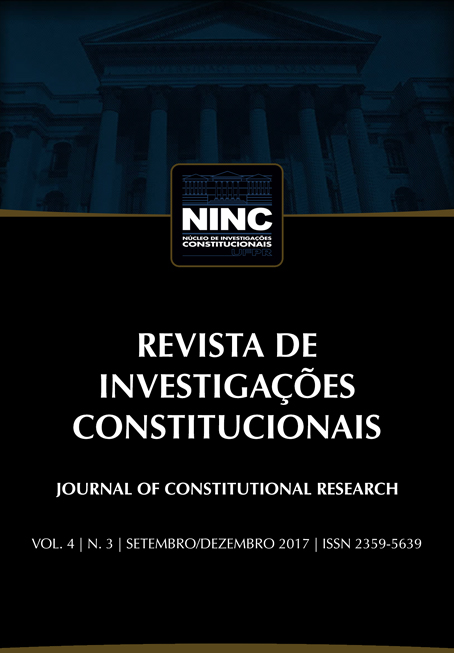Unconstitutional limbo: why the Smithsonian Institution may violate the separation of powers doctrine
DOI:
https://doi.org/10.5380/rinc.v4i3.50286Palavras-chave:
unconstitucional, separation of powers, Smithsonian Institution, American Administrative Law, governmental entity.Resumo
With the opening of the National Museum of African-American History, people are once again coming in mass to the National Mall to see the Smithsonian’s newest edition. And just about everyone in America knows of the Smithsonian--its name recognition is well over 90% in public surveys. Each year 30 million people visit the Smithsonian museums along the National Mall in Washington, D.C., the National Air and Space Museum, the National Museum of American History, and the National Museum of Natural History among them. But is that about to change? The Smithsonian is an odd government entity. Despite its private, non-profit status, the Smithsonian still receives federal funds, is chartered by an Act of Congress, employs a majority civil service staff, and operates through a board overseen by the Chief Justice of the Supreme Court, the Vice President, and legislators from the United States Senate and Congress. As such, the Smithsonian has been deemed a governmental entity is some instances and a private entity in others. However, with a new bill being introduced to Congress and recent Supreme Court precedent regarding government instrumentalities, the Smithsonian may face dissolution of its current supervisory board less it run the risk of violating the separation of powers doctrine.
Referências
BATTIATA, Mary. Saudi Gift Controversy at the Smithsonian. Washington Post, Washington, 9 oct. 1985. Available at: <https://www.washingtonpost.com/archive/lifestyle/1985/10/09/saudi-gift-controversy-at-the smithsonian/ac61fda89bf5-4398-9b78-296ed18e7678/>.
CURRIE, David P. The Smithsonian. The University of Chicago Law Review, Chicago, vol. 70, n. 1, p. 65-71, jan./mar. 2003.
DELLINGER, Walter. The Constitutional Separation of Powers Between the President and Congress. Opinion of the Office of Legal Concern, Washington, vol. 20. p. 124-18, may 1996. Available at: < https://www.justice.gov/sites/default/files/olc/opinions/1996/05/31/op-olc-v020-p0124_0.pdf>.
GOODE, George Brown (Ed.). The Smithsonian Institution, 1846-1896, The History of its First Half Century. New York: De Vinne Press, 1897.
HIRSCH, Arthur. Smithsonian Cancels Exhibit on Atomic Bomb. Baltimore Sun Times, Baltimore, jan. 31 1995. Available at: <http://articles.baltimoresun.com/1995-01-31/features/1995031159_1_heyman-atomic-enola-gay>.
KMIEC, Douglas W. The Status of the Smithsonian Institution Under the Federal Property and Administrative Services Act. Opinion of the Office of Legal Concern, Washington, vol. 12, 122-127, june 1988. Available at: <https://www.justice.gov/file/24096/download>.
MANNING, John F. Separation of Powers As Ordinary Interpretation. Harvard Law Review, Cambridge, vol. 124, p. 1942-2040, 1939.
MITTAL, Anu K. Key Federal Agencies’ and the Smithsonian Institution’s efforts to Identify and Repatriate Indian Human Remains and Objects. Available at: <http://www.gao.gov/assets/130/126466.pdf>.
SMITHSONIAN INSTITUTION. General History. Smithsonian Archives. Available at: <http://siarchives.si.edu/history/general-history>.
SMITHSONIAN INSTITUTION. Legal Nature of the Smithsonian. Available at: .
SMITHSONIAN INSTITUTION. Memorandum for the Director, Office of Personnel Management from Assistant Attorney General Ulman. Opinion of the Office of Legal Concern, Washington, vol. 3, 1979.
SMITHSONIAN INSTITUTION. Smithsonian Institution FY 2016 Budget Justification to Congress. Available at: <http://www.si.edu/content/pdf/about/fy2016-budgetrequest.pdf>.
STRAUSS, Peter. Formal & Functional Approcaches to Separation of Powers Questions – A Foolish Inconsistency? Cornell Law Review, New York, vol. 72, n. 3, p. 488-526, mar. 1987.
UNITED STATES. Memorandum for the Director, Office of Personnel Management from Assistant Attorney General Ulman. Opinion of the Office of Legal Concern, Washington, vol. 3, 274-242, 1979.
Downloads
Publicado
Como Citar
Edição
Seção
Licença
Autores que publicam nesta revista concordam com os seguintes termos:- Autores mantém os direitos autorais e concedem à revista o direito de primeira publicação, com o trabalho simultaneamente licenciado sob a Creative Commons - Atribuição 4.0 Internacional que permite o compartilhamento do trabalho com reconhecimento da autoria e publicação inicial nesta revista.
- Autores têm autorização para assumir contratos adicionais separadamente, para distribuição não-exclusiva da versão do trabalho publicada nesta revista (ex.: publicar em repositório institucional ou como capítulo de livro), com reconhecimento de autoria e publicação inicial nesta revista.
- Autores têm permissão e são estimulados a publicar e distribuir seu trabalho online (ex.: em repositórios institucionais ou na sua página pessoal) a qualquer ponto antes ou durante o processo editorial, já que isso pode gerar alterações produtivas, bem como aumentar o impacto e a citação do trabalho publicado (Veja O Efeito do Acesso Livre).
























